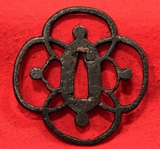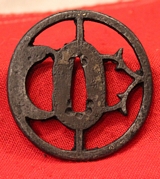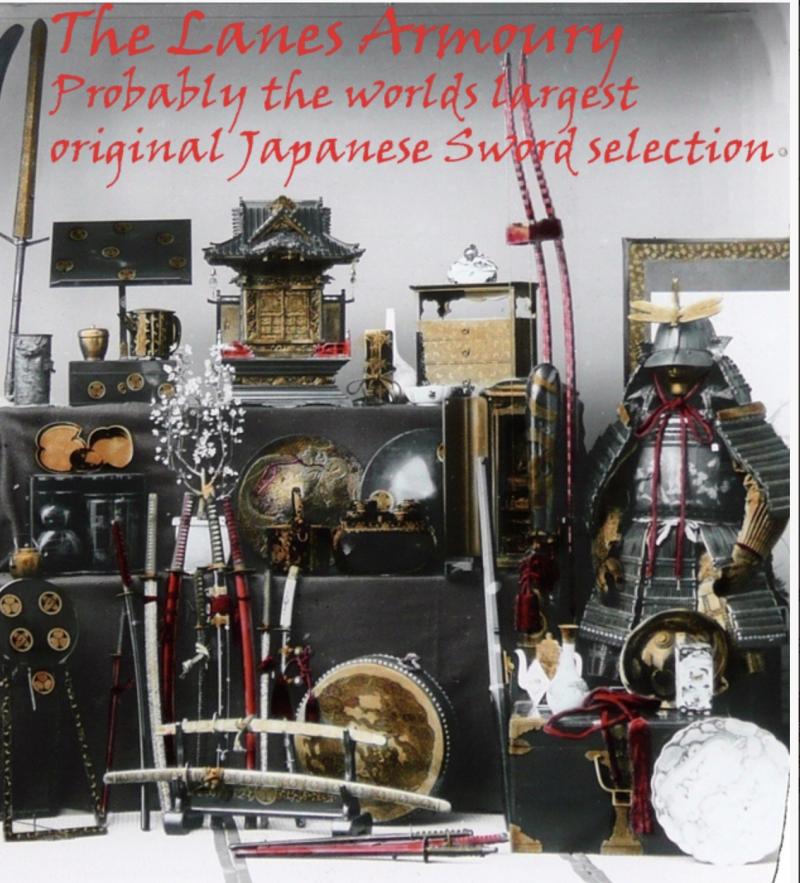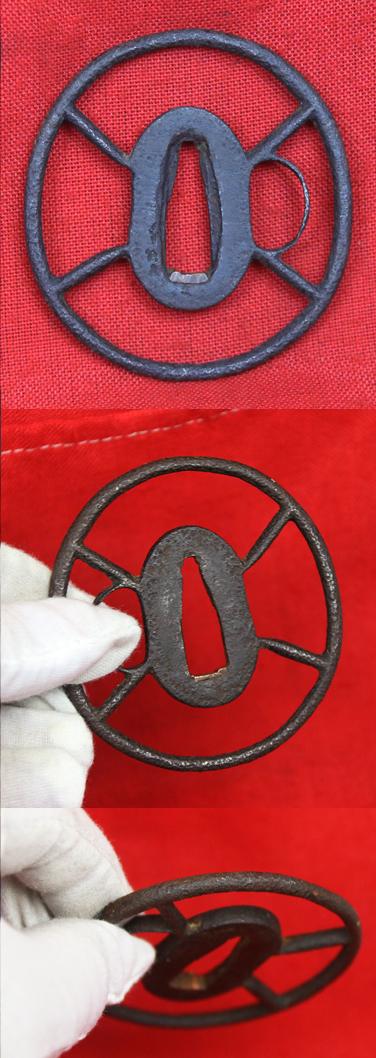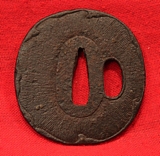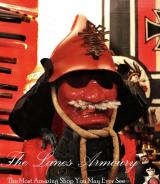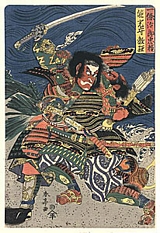Japanese
A Koto Period O-Sukashi Katana Tsuba
Circa 1550. Tsuba were made by whole dynasties of craftsmen whose only craft was making tsuba. They were usually lavishly decorated. In addition to being collectors items, they were often used as heirlooms, passed from one generation to the next. Japanese families with samurai roots sometimes have their family crest (mon) crafted onto a tsuba. Tsuba can be found in a variety of metals and alloys, including iron, steel, brass, copper and shakudo. In a duel, two participants may lock their katana together at the point of the tsuba and push, trying to gain a better position from which to strike the other down. This is known as tsubazeriai pushing tsuba against each other. read more
375.00 GBP
A Most Interesting Late Edo Japanese Gilt Lacquer Wooden Sword and Samurai Artifact Folding Display Stand. Decorated with Hand Painted Cranes and Bamboo
A folding wood and hand painted lacquer sword rack display stand, for the display of three samurai swords and for the area beneath for the decoration of samurai artefacts such as sword fittngs, mempo, abumi, war fans, or, such as beautiful Japanese tea ceremony pieces, early iron water vessels, and tea bowls etc.
See a selection of items shown for illustrative purposes.
Signed by the artist on both the obverse and reverse side. The hand painted cranes and bamboo are on fine gold leaf covered panels, and show considerable age wear, but this enhances its air of contrived antiquity for the display of early samurai swords, weaponry and artefacts
It has long been the tradition of areas of Japanese art to make for display late Edo pieces, in the much earlier ancient forms and styles. Such as, for example, russetted Higo style iron sword mounts. Actually made in the 18th century, but made to appear as they were ancient iron pieces from many centuries before. In many respects as an homage to much revered ancient Japanese art forms read more
1425.00 GBP
A Good Antique Edo Period Round Signed Tetsu Wakazashi Tsuba Embossed Seashells
A delightful iron round tsuba takebori patterned with various shells over a water pattern background, with ana openings for kozuka and kogai. The Tsuba can be solid, semi pierced of fully pierced, with an overall perforated design, but it always a central opening which narrows at its peak for the blade to fit within. It often can have openings for the kozuka and kogai to pass through, and these openings can also often be filled with metal to seal them closed. For the Samurai, it also functioned as an article of distinction, as his sole personal ornament 61 mm read more
225.00 GBP
An Edo O Sukashi Wakazashi or Tanto Tsuba In Iron
Circa 1650. The Tsuba, or Japanese sword guard, is a refined utilitarian object. It is essentially a sheath for the blade to fit through, protecting the hand of the warrior. The Tsuba can be solid, semi pierced of fully pierced, with an overall perforated design, but it always a central opening which narrows at its peak for the blade to fit within. It often can have openings for the kozuka and kogai to pass through, and these openings can also also often be filled with metal to seal them closed. For the Samurai, it also functioned as an article of distinction, as his sole personal ornament. read more
265.00 GBP
The Lanes Armoury & The Hawkins Family Established For Over 100 Years
In fact the family has been trading in Brighton for likely 200 years, but the first 100 Years was in the local fish and shellfish trade, becoming shopkeepers in antiques in the town in the last 100 years. Apparently the family moved from our seafaring roots in Plymouth, around 200 years ago, where we had been trading since the 1500’s, and during reign of The Tudors, Admiral Sir Francis Drake had been an adopted apprentice from the age of 15 of the Hawkins family in Plymouth..
The current partners, Mark and David have between them almost 95 years combined service to the company, serving the public and trade in ‘The Lanes’ of Brighton. In fact, we believe, out of approximately 2000 shops, and goodness knows how many businesses in the city, we are now the oldest, remaining, established family traders within the whole of Brighton and Hove.
BRIGHTON and Hove has been named the second-best area for independent shopping in the United Kingdom, only just pipped at the post by Cambridge. If you are going to be beaten by a town at least it was Cambridge [apologies to Oxford, but you ought to be used to it by now]
Taken from the Brighton and Hove.gov website; ‘The Lanes’ is listed first of the four main shopping areas; ‘ The Lanes - historic maze of alleyways with a mix of antiques, jewellery and fashion’
But sadly, we are the only antique and bookshop now still remaining in ‘The Lanes’ read more
Price
on
Request
A Very Rare WW2 Japanese Shell Case From a Type 11 37mm Infantry Anti Tank Gun
Souvenir of an British officer gifted to him by an Australian officer, who served in the Pacific War in WW2. All Japanese munitions from WW2 are incredibly rare to see in the UK as so few returning soldiers bothered to collect them and bring them home, plus all WW2 arms of all kinds were destroyed in Japan from 1945. For them it was a determined effort to wipe out all mention and thought of WW2 and to eradicate any reminder of the shame. All marked items of that period were banned, and in fact a rule that is still enforced in Japan today. The shell schematics are; Calibre Diameter: 37mm
Case Length: 132mm
Rim: R
Round Index: Shell Type 95 AP
Projectile Index: Type 95 AP
Projectile Weight: 0,67000 kg
Filler Weight: 0,03500 kg
Usage: Type 11 37mm Infantry Gun, Type 94 37mm Anti-Tank Gun & Type 94 37mm Tank Gun
Armour piercing/high Explosive round for Type 11 Infantry Gun, early Type 94 AT & Tank Guns. Inert and safe not suitable for export. read more
125.00 GBP
A Super Early Samurai Sword Katana Tsuba, Kanayama and Ono School
Kanayama and Ono school tettsu tsuba, Circa 1400
Kanayama Tsuba exhibit a well forged iron with a hammered surface with prominent Tsuchime similar to Owari Tsuba but with stronger Tekkotsu visible in the rim and surface. The origin of Kanayama tsuba is still not a hundred percent clear, but most sources name a city close to Nagoya in the Owari province. In the early Edo period Ono Tsuba developed out of the Kanayama school and continued their tradition with various designs but a bit smaller in size.
The Kanayama school
Beginning in mid Muromachi to the end of Genroku (ca. 1400 to 1710). For purposes of study, the period of production is divided into three sections: the first period is the Muromachi age, second period is Momoyama age, and the third period are the pieces made in Kyoto during the Edo age. Normally round, sometimes oval.
the tsuba's seppa dai is a very good shape, squarish at top and bottom. Usually Thickness 3 to 5.09mm. this tsuba is 5 mm thick . It appears slightly large for the size of the tsuba and slightly more oblong than those found on Owari tsuba.
Many tsuba of the school have thin, raised square peripheral rims (later examples have rounded rims) with 'tekkotsu' visible.
Design Characteristics:
This school would seem to be the earliest to use ji-sukashi (positive silhouette). Most of the designs are plain, direct, and abstract, consisting largely of straight or curved lines that produce a feeling of great dignity. The openwork is so extensive that the remaining metal portions are very fine and slender.
Antique Japanese koshirae [Japanese samurai sword mounts, tsuba and fittings] are considered as fine object d'art in their own right, and have been collectable as individual items or sets, since the Edo period. They were often removed from swords, mounted in small cases, and respectfully admired for display as items of the highest quality workmanship, and symbols of the noble samurai, in their own right. Some koshirae collectors never actually have any interest in the blades themselves, and individual pieces can attain values of tens of thousands of pounds, and there are many multi million pound collections, in and out of museums, comprising of some of the finest examples of Japanese un-mounted sword fittings from the samurai historical period.
70mm across read more
675.00 GBP
Iron Round Chisa Katana or Wakazashi Tsuba With Amidayasuri and Wave Rim
Koto period circa 1550 with very finely chisseled designs. Tsuba are usually finely decorated, and are highly desirable collectors' items in their own right. Tsuba were made by whole dynasties of craftsmen whose only craft was making tsuba. They were usually lavishly decorated. In addition to being collectors items, they were often used as heirlooms, passed from one generation to the next. Japanese families with samurai roots sometimes have their family crest (mon) crafted onto a tsuba. Tsuba can be found in a variety of metals and alloys, including iron, steel, brass, copper and shakudo. In a duel, two participants may lock their katana together at the point of the tsuba and push, trying to gain a better position from which to strike the other down. This is known as tsubazeriai pushing tsuba against each other. read more
375.00 GBP
Europe’s Leading Original Samurai Sword Specialists
After 50 years personal experience by Mark, since 1971, we are Europe’s leading samurai sword specialists, with hundreds of swords to view and buy online 24/7, or in our store on a personal visit, 6 days a week. In fact we know of no better and varied original samurai sword selection for sale under one roof outside of Japan, or probably, even within it. Hundreds of original pieces up to 800 years old. Whether we are selling to our clients representing museums around the globe, the world’s leading collectors, or simply a first time buyer, we offer our advice and guidance in order to assist and guide the next custodian of a fine Japanese sword, to make the very best choice for them.
Both of the partners of the company have spent literally all of their lives surrounded by objects of history, trained, almost since birth in the arts and history. Supervised and mentored, first by their grandfather, then their father, who left the RAF sometime after the war, to become one of the leading antique exporters and dealers in the entire world. Selling, around the whole world, in today’s equivalent, hundreds of millions of pounds of antiques and works of art. Both Mark and David were incredibly fortunate to be mentored by some of the world’s leading experts within their fields of antiques and militaria. Mark has been a director and partner in the family businesses since 1971, but long before that he was handling and buying swords and flintlocks since he was just seven years old, obviously in a very limited way though, naturally. David, Mark’s younger brother, also started collecting militaria when he was seven, and as you will by now guess, history, antiques and militaria is simply in their blood. read more
Price
on
Request
Please View Probably The Best Selection Of Original & Varied Samurai Arms in Europe & Possibly the World
Please View One of The Best Selections Of Original Samurai Arms to be Seen. Over the past 49 years I have personally supervised our company's determination to provide the most interesting, educational, yet not too intimidating, gallery of original Japanese Samurai weapons, helmets, sword fittings, polearms, muskets and armour. Principally concentrating on swords and daggers, with a combination of age, beauty, quality and history. Thanks to an extensive contact base [built up over the past 100 years or more] that stretches across the whole world, including collectors [both large and small], curators, academics and consultants, we have been very fortunate, that this effort has rewarded us with the ability to offer, what we believe to be, the most comprehensive selection available in Europe, if not the world, and during that time we have handled likely tens of thousands of original samurai artefacts and swords. In one week I sent over 300 samurai swords and daggers to be sold at our business in Georgia, USA [in the 1970’s we found the best market for Japanese swords was America]. Some of the most learned scholars studying this art all their lives often only scratch the surface of the knowledge to be learnt in this field, and like them, we have always loved the incredible history of the Samurai, and admired, respected and envied the unparalleled quality and beauty of their swords. Our Japanese weapons vary in age up to 800 years old, and are frequently some of the finest examples of specialist workmanship ever achieved by mankind. We have tried to include, within the description of some items, a brief history lesson, for those that are interested, and may not know, that will describe the eras, areas and circumstances in which these items were used. We have tried our utmost to be informative and interesting without being too academic in order to keep the details vibrant, fascinating yet not too complex. Please enjoy, with our compliments, our Japanese Gallery. It has been decades in the creation, and we intend it to remain interesting and informative, hopefully, for decades to come. Although they appear to be likely a relative expensive luxury compared to other antique swords from other nations, they are in fact incredible value for money, for example a newly made bespoke samurai style sword blade from Japan will cost, today, in excess of £11,000, take up to two years to complete, will come with no fittings at all, and will be modern [naturally] with no historical context or connection to the ancient samurai past in any way at all. Our fabulous original swords can be many, many, hundreds of years old, stunningly mounted as fabulous quality works of art, and may have been owned and used by up to 30 samurai in their working lifetime. Plus, due to their status in Japanese society, look almost as good today as the did possibly up to 500 years ago, or even more. Mark Hawkins [Partner]. read more
Price
on
Request


